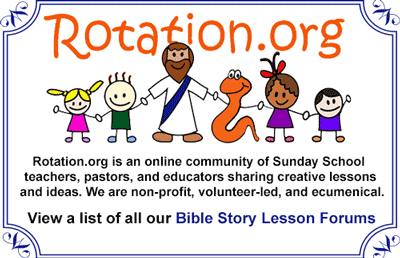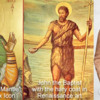This topic is collecting teachable Bible Background Info on John the Baptist and the Baptism of Jesus for Sunday School.
You are welcome to post your own insights and those of your particular denomination.
If you have a lesson idea, please post it in the appropriate topic in the John the Baptist, Baptism of Jesus lesson forum.
John the Baptist's hairy coat was not "scratchy"
If  you're like me, you grew up with the misconception that John the Baptist was a "wild and itchy" guy dressed up in hairy camel skins like some sort of Bible caveman.
you're like me, you grew up with the misconception that John the Baptist was a "wild and itchy" guy dressed up in hairy camel skins like some sort of Bible caveman.
Artist without much biblical knowledge (or care) have often portrayed him as such, and it fed into a certain "wild and penitential" view of prophets as a group of aesthetic monks "doing without" things like decent clothing and "subsisting" on locusts and honey while their scratchy hair tormented them all day as an act of penance.
But that image is not only probably wrong, it misses the scriptural connection between John the Baptist and Elijah, and the purpose of the prophet's cloak.
Thing is... Camel's hair is not necessarily SCRATCHY and in fact, can be quite soft. Technically speaking a camel has two kinds of hair, an outer thicker hair called "guard" hair, and an inner "undercoat" hair which is shorter and softer. Both can be processed and blended with other hair (like wool), and together they make a fine garment that's especially good at shedding the rain and insulating against the cold. Read more about Camel's hair.

The Gospels actually describe John the Baptist as wearing an "outer garment" made out of camel's hair, not a "hair shirt." In other words, he had a camel's hair coat. The Greek word used in Matthew 3:4 to describe his coat is "enduma" -- meaning "garment, raiment, cloak, an outer garment." Here's the Greek reference.
And nobody in Jesus' day would have mistaken the symbolism of John's camel's hair garment, because it was what prophets wore; prophet's like Elijah who started the tradition in 2 Kings 1:8...
“He had a garment of hair and had a leather belt around his waist.”
Other travelers would have worn camel's hair too, especially in the rainy or cold months in Israel. The camel's hair coat or cloak or would have been worn over a robe or undergarments. Here's an excellent article about clothing in biblical times.
It's even possible that Jesus had a camel's hair cloak when he traveled. We are conditioned to imagining him in a roman robe or simple garment, but when he was traveling, an outer garment would have been a necessity. It would have made a nice bedroll too.
Just like any article of clothing can be "tailored" to send a message or become a uniform of sorts, so too a prophet's mantle could be an unmistakable message to those who could read the sign. They were a calling card like a pastor's robe or doctor's lab coat. Wear them and people took notice of you, even Kings who might otherwise not want to listen to you. Indeed, in Zechariah 13:4 we read about "false" prophets no longer being allowed to deceive the people by wearing their hairy mantles.
Matthew 3:4's description of John's "hairy" coat also preserves a humorous Hebrew "double entendre" about Elijah.
In both the English and Hebrew languages, the word for "hairy" can be understood both literally and figuratively. Literally as in "covered with hair, or made of hair" (se`ar). And figuratively as in "wild, bristling, or tempestuous" (sa-`ar)—which the prophet's appearance and message would often convey. 2 Kings 1:8 LITERALLY calls Elijah a "hairy man." And some translators use that literal wording too. But perhaps "hair-wearing & hair-raising is a better explanation of both Elijah and John's mantle and mission.
The Gospels' Greek word for "hair" (thrix) seems to be simply literal because the writers were Greek and had a Greek copy of the scriptures, and thus, maybe didn't know about the "hair-raising" interpretation.
But to John and the disciples, there was no confusion!
John was dressed like Elijah, the great prophet
who was expected to return when the Messiah was about to appear.
In fact, people asked if John was Elijah returned!
When asked "who is John the Baptist," Jesus replies, "he is the Elijah who was to come." (Matthew 11:14. also, Mk 9:14). Now oddly enough, according to John 1:19, John said he was "not Elijah." This undoubtedly gave rise to the understanding that John was, as Luke 1:15-17 says, "in the spirit and power of Elijah." This also proves that Jesus wasn't a literalist when he referred to John as Elijah. ![]()
The Misconceptions About "Locust and Wild Honey"
The "locusts and honey" John is described as eating in Matthew 3:4 are also probably not what we have casually believed they were, i.e., what a "half-crazed desert prophet" would have subsisted on. Instead, that description too was a sign, a sign of the Kingdom.
According to NT scholar James Tabor... John was not eating bugs.
The Greek word for locusts (akris/ἀκρίδες) is very similar to the Greek word for “honey cake” (enkris/έγκρίς) that is used for the “manna” that the Israelites ate in the desert in the days of Moses. "Locusts" thus refers to a kind of cake cooked in olive oil. This “bread from heaven” is described as “like coriander seed, white, and the taste of it was like wafers made with honey” (Exodus 16:31; Numbers 11:8).
This kind of “manna pancake” baked in oil and sweetened with honey was a sign to the reader about the miracle in the wilderness that God had already and was again going to bring forth. It should not be lost on us that recorded in all four Gospels is the story of Jesus himself multiplying the loaves and fishes in the wilderness to feed the 5000. No honey, but pretty sweet nonetheless.
![]() John's symbolic food of "locusts and honey" was a sign that the Kingdom of God was at hand, which not so coincidentally was what he was preaching, and was the same sign Elijah used in Zarephath, and Jesus used in Galilee.
John's symbolic food of "locusts and honey" was a sign that the Kingdom of God was at hand, which not so coincidentally was what he was preaching, and was the same sign Elijah used in Zarephath, and Jesus used in Galilee.
John's camel's hair mantle and locust and honey were "voices crying out in the wilderness" to those who knew their Bible and were listening.
The truth here is better than the strange fiction of the wild and itchy man we grew up imagining.
<>< Neil MacQueen








 There is a historic and modern tradition that wants to portray John (and Jesus) as vegetarians. Bugs are considered non-vegetarian.
There is a historic and modern tradition that wants to portray John (and Jesus) as vegetarians. Bugs are considered non-vegetarian.

